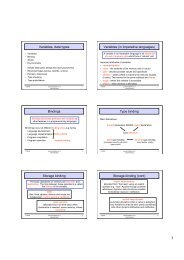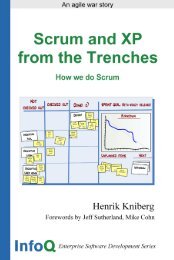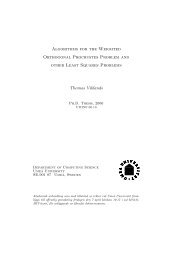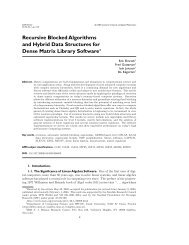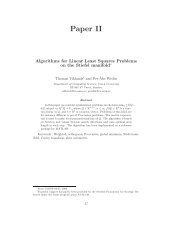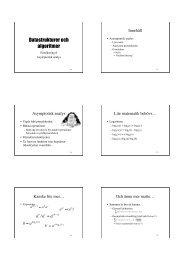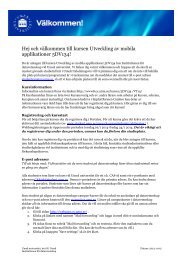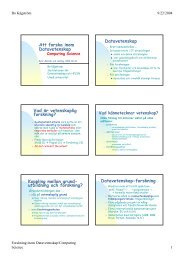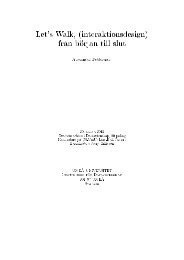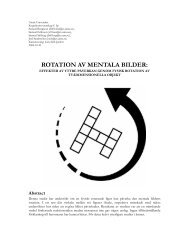Sample set of questions for the UBICOMP written examination
Sample set of questions for the UBICOMP written examination
Sample set of questions for the UBICOMP written examination
Create successful ePaper yourself
Turn your PDF publications into a flip-book with our unique Google optimized e-Paper software.
<strong>Sample</strong> <strong>set</strong> <strong>of</strong> <strong>questions</strong> <strong>for</strong> <strong>the</strong> <strong>UBICOMP</strong> <strong>written</strong> <strong>examination</strong><br />
Ubiquitous/Pervasive Computing<br />
1. Discuss about <strong>the</strong> 3 Phases <strong>of</strong> Computer use. (1.5P)<br />
2. Who is said to be <strong>the</strong> Founder <strong>of</strong> Ubiquitous Computing? (0.5P)<br />
3. What is <strong>the</strong> Vision <strong>of</strong> Ubiquitous Computing? (1P)<br />
4. What is Invisibility within <strong>the</strong> context <strong>of</strong> ubiquitous computing? (1P)<br />
5. What is Localized Scalability? (1P)<br />
6. What is Uneven Conditioning? (1P)<br />
7. What is Cyber Foraging? (1P)<br />
8. Why is User Intent important to consider in designing <strong>UBICOMP</strong> systems? (1P)<br />
9. Discuss about Client Thickness within <strong>the</strong> context <strong>of</strong> ubiquitous computing. (1P)<br />
10. Discuss about <strong>the</strong> following 4 challenges within ubiquitous computing namely:<br />
Proactivity, Transparency, Privacy and Trust. (2P)<br />
11. Why is High-Level Energy Management important in designing <strong>UBICOMP</strong><br />
systems? (1P)<br />
12. Discuss about Adaptation Strategy from a <strong>UBICOMP</strong> perspective. (1P)<br />
Context-Aware Computing<br />
1. What is Context? When is a system Context-Aware? (1P)<br />
2. Mention any 2 Features <strong>of</strong> Context-Aware applications. (1P)<br />
3. Why do Context-Aware systems have difficult decisions to make? (2P)<br />
4. Discuss about Context-Awareness as a response to: a) <strong>the</strong> Environment; b)<br />
People; and c) <strong>the</strong> Interpersonal (Social Context). (1.5P)<br />
5. Discuss any 3 Design Principles <strong>for</strong> building Context-Aware systems. (1.5P)<br />
Location-Aware Computing<br />
1. What is Location Aware Computing? (0.5P)<br />
2. What are <strong>the</strong> 3 Approaches <strong>for</strong> Automatic Location Sensing? (1.5P)<br />
3. Discuss about Triangulation based Location Tracking. (2P)<br />
4. Discuss about Scene Analysis as an approach <strong>for</strong> Location Tracking. (1P)<br />
5. Discuss about Proximity based Location Tracking. (1P)
8. Describe any 4 Location Tracking System Properties. (2P)<br />
9. What is <strong>the</strong> difference between Physical and Symbolic Locations? (1P).<br />
10. Describe any 2 Location Tracking Systems. (2P)<br />
11. Discuss any 4 Applications <strong>of</strong> Location Tracking Systems. (2P)<br />
Activity-Aware Computing<br />
1. Discuss about Complex Sensors based Activity Recognition. (1P)<br />
2. Discuss about Body-Worn Sensors based Activity Recognition. (1P)<br />
3. Discuss about RFID based Activity Recognition. (1P)<br />
4. Discuss about State Change Sensors based Activity Recognition. (1P)<br />
5. What are <strong>the</strong> Challenges (mention any 4) within <strong>the</strong> field <strong>of</strong> Activity Recognition?<br />
(2P)<br />
6. What are <strong>the</strong> Advantages (mention any 2) <strong>of</strong> VR simulation <strong>for</strong> building activity<br />
recognition systems? (1P)<br />
7. What is In<strong>for</strong>mation Channel Fusion within <strong>the</strong> context <strong>of</strong> activity recognition?<br />
How is it useful? (2P)<br />
Graspable/Tangible Interfaces<br />
1. What is a Token and what is a Constraint within Tangible User Interfaces? (1P)<br />
2. Discuss about <strong>the</strong> following 2 Phases <strong>of</strong> Interaction within tangible interfaces<br />
namely: a) Association and b) Manipulation. (1P)<br />
3. Describe any 2 Application areas <strong>for</strong> Tangible Interfaces. Discuss <strong>the</strong>ir<br />
Advantages over traditional WIMP Interfaces. (2P)<br />
4. What are Tangible Interfaces? (1P)<br />
5. Imagine and describe a future application where tangible interfaces could be used<br />
to support human activities. (1P)<br />
Smart Homes and Smart Object Systems<br />
1. What are Smart Homes? What are <strong>the</strong>ir Features? (1P)<br />
2. Discuss about Smart Homes <strong>for</strong> Elderly or Disabled with examples. (1P)<br />
3. What is Home Automation? How is it different to Semi-automated Approaches?<br />
Provide examples and discuss fur<strong>the</strong>r. (2P)<br />
4. Describe and discuss about any 4 Challenges in deploying ubiquitous computing<br />
technologies in a Home Environment. (2P)<br />
5. What are Smart Objects? Describe <strong>the</strong> 3 Types <strong>of</strong> Smart Object Systems with<br />
examples (2P)<br />
6. What are Smart Objects? Discuss <strong>the</strong> differences between Standalone and Cooperative<br />
Smart Objects. (1.5 P)<br />
Wearable Computing<br />
1. What is a Wearable Computer? How is it different to a PDA? (1P)<br />
2. What is Licklider's Vision <strong>of</strong> "Man-Computer Symbiosis"? (1P)
3. Discuss any 4 Application areas where Wearable Computers could be useful. (2P)<br />
4. Discuss about <strong>the</strong> following 4 Challenges within Wearable Computing research:<br />
User Interface, Power Use, Heat Dissipation, and Networking (2P)<br />
5. Describe <strong>the</strong> Common Parts <strong>of</strong> a Wearable Computer. (1P)<br />
Augmented/Mixed Reality<br />
1. What is Augmented Reality? How is it different to Mixed Reality? (1P)<br />
2. Describe Milgram's Reality-Virtuality Continuum with examples. (1P)<br />
3. What is Augmented Reality? How is it different to Virtual Reality? (1P)<br />
4. Describe any 4 Application areas <strong>for</strong> Augmented Reality. Provide suitable<br />
examples and discuss how Augmented Reality technologies can improve <strong>the</strong><br />
mentioned application areas. (2P)<br />
5. What are <strong>the</strong> differences between Optical see-through HMD and Video seethrough<br />
HMD? (2P)<br />
6. What is Registration Problem? Discuss and compare Static Registration Errors<br />
with Dynamic Registration Errors. (2P)<br />
<strong>UBICOMP</strong> Applications<br />
1. What is Vineyard Computing? (0.5P)<br />
2. Why are Ethnographical Studies important <strong>for</strong> Vineyard Computing? Describe<br />
and discuss its influence on Vineyard Computing. (2P)<br />
3. Describe <strong>the</strong> 3 Important Factors to consider within Vineyard Computing. (1.5P)<br />
4. Discuss about Proactive Computing within <strong>the</strong> context <strong>of</strong> Vineyard Computing.<br />
(1P)<br />
5. Discuss with an example how understanding <strong>the</strong> Vineyard Work could influence<br />
<strong>the</strong> System Design. (1P)<br />
6. You are supposed to design a <strong>UBICOMP</strong> system <strong>for</strong> Fire Fighters. What are <strong>the</strong> 3<br />
Methods that you might consider to obtain more in<strong>for</strong>mation about this domain?<br />
(1.5P)<br />
7. Discuss <strong>the</strong> following 4 Design Challenges namely Accountability, Assessment,<br />
Resource Allocation and Communication in designing a <strong>UBICOMP</strong> system <strong>for</strong><br />
fire-fighters (2P).<br />
Evaluation Techniques<br />
1. Why do we need an Evaluation Framework <strong>for</strong> <strong>UBICOMP</strong> applications? (2P)<br />
2. Discuss about any 4 Evaluation Areas. (2P)<br />
3. Discuss about Attention, Adoption and Trust as Evaluation Areas <strong>for</strong> <strong>UBICOMP</strong><br />
applications (1.5P)<br />
4. Discuss about Interaction, Invisibility and Conceptual Models as Evaluation<br />
Areas <strong>for</strong> <strong>UBICOMP</strong> applications (1.5P)<br />
5. Discuss about VR Simulation based Evaluation, Live-in Laboratory Evaluation<br />
and In-Situ Evaluation. (1.5P)



